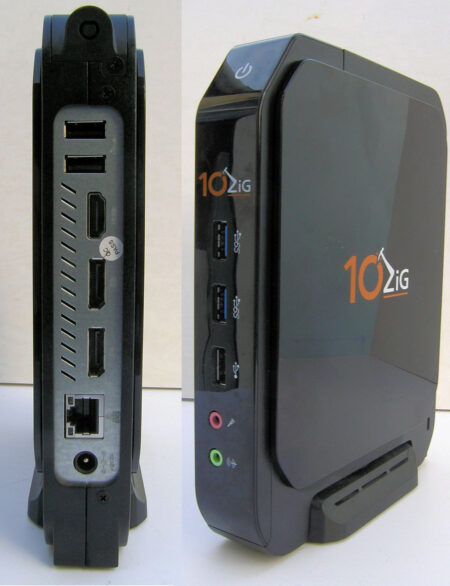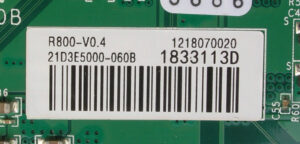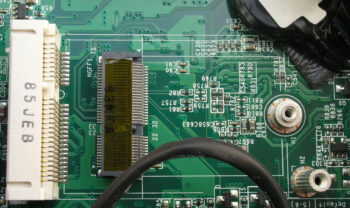

The series was launched in August 2017 and, judging by the label on the motherboard located under the RAM, is based on the Clientron R800. At the time of writing (Jan 2022) it is shown as a current 10ZiG product.
The Clientron R800 datasheet I tracked down gives the CPU as a Celeron N3160 rather than the N3710 fitted to the 59xxq. Both CPUs were launched in Q1 2016 and a quick glance at the respective datasheets shows that the N3710 has the edge in having a higher burst frequency, slightly higher graphics frequency and 16 (graphics) execution units as opposed to 12. (Hence customer prices for the CPUs of $50 and $31 respectively). I guess 10ZiG picked the higher spec for the 59xxq.
The 59xxq includes an integral foot. It is a swivel foot and is not deployed in the picture above but is shown in action later under the USB section.
Processor Type
SpeedIntel Pentium N3710 (Quad Core)
1.6GHz (2.56GHz burst)Memory Flash
RAM4GB/16GB
4GB (max 8GB)Video Chip
Max resolution
Intel HD Graphics 400
3840 x 2160 @30Hz / 2560 x 1600 @ 60Hz
(3 monitors at 4K UHD)Ports Network
USB
Serial
Parallel
PS/2
Video10/100/1000
5 x USB2.0
2 x USB3.0
0
0
0
2 x DisplayPort, 1 x HDMIPower Plug
Input
Off
idle
RunningCoax 5.5mm/2.1mm
12V/3A(datasheet)
<1W
4W
6WDimensions H x W x D (mm) 193 x 49 x 149
Originally launched as the 5900q (5972q (linux) 5910q (Win10 IoT)
Later we have 5948qv (VMware), 5948qc (Citrix), 5948qm (Microsoft)
Today (Jan 2022) we seem to be back to 5972q and 5910q.
The unit requires a 12V supply and uses a conventional 5.5mm/2.1mm coax connector. The label on the base says 12V 3A.
The CPU is a quad-core Celeron N3710. Having booted Tinycore, /proc/cpuinfo shows:
vendor_id : GenuineIntel cpu family : 6 model : 76 model name : Intel(R) Pentium(R) CPU N3710 @ 1.60GHz stepping : 4 flags : fpu vme de pse tsc msr pae mce cx8 apic sep mtrr pge mca cmov pat pse36 clflush dts acpi mmx fxsr sse sse2 ss ht tm pbe nx rdtscp lm constant_tsc arch_perfmon pebs bts xtopology tsc_reliable nonstop_tsc cpuid aperfmperf tsc_known_freq pni pclmulqdq dtes64 monitor ds_cpl vmx est tm2 ssse3 cx16 xtpr pdcm sse4_1 sse4_2 movbe popcnt tsc_deadline_timer aes rdrand lahf_lm 3dnowprefetch epb ibrs ibpb stibp tpr_shadow vnmi flexpriority ept vpid tsc_adjust smep erms dtherm ida arat vmx flags : vnmi preemption_timer invvpid ept_x_only flexpriority tsc_offset vtpr mtf vapic ept vpid unrestricted_guest
00:00.0 Host bridge: Intel Corporation Atom/Celeron/Pentium Processor x5-E8000/J3xxx/N3xxx Series SoC Transaction Register (rev 35) 00:02.0 VGA compatible controller: Intel Corporation Atom/Celeron/Pentium Processor x5-E8000/J3xxx/N3xxx Integrated Graphics Controller (rev 35) 00:13.0 SATA controller: Intel Corporation Atom/Celeron/Pentium Processor x5-E8000/J3xxx/N3xxx Series SATA Controller (rev 35) 00:14.0 USB controller: Intel Corporation Atom/Celeron/Pentium Processor x5-E8000/J3xxx/N3xxx Series USB xHCI Controller (rev 35) 00:1a.0 Encryption controller: Intel Corporation Atom/Celeron/Pentium Processor x5-E8000/J3xxx/N3xxx Series Trusted Execution Engine (rev 35) 00:1b.0 Audio device: Intel Corporation Atom/Celeron/Pentium Processor x5-E8000/J3xxx/N3xxx Series High Definition Audio Controller (rev 35) 00:1c.0 PCI bridge: Intel Corporation Atom/Celeron/Pentium Processor x5-E8000/J3xxx/N3xxx Series PCI Express Port #1 (rev 35) 00:1c.2 PCI bridge: Intel Corporation Atom/Celeron/Pentium Processor x5-E8000/J3xxx/N3xxx Series PCI Express Port #3 (rev 35) 00:1f.0 ISA bridge: Intel Corporation Atom/Celeron/Pentium Processor x5-E8000/J3xxx/N3xxx Series PCU (rev 35) 00:1f.3 SMBus: Intel Corporation Atom/Celeron/Pentium Processor x5-E8000/J3xxx/N3xxx SMBus Controller (rev 35) 02:00.0 Ethernet controller: Realtek Semiconductor Co., Ltd. RTL8111/8168/8411 PCI Express Gigabit Ethernet Controller (rev 07)
The case is fairly compact in size so there is little space to fit anything internally other than what is provided as standard.
The disassembly instructions show you how to get to the RAM and expansion sockets.
Flash: The standard Flash memory is soldered to the motherboard. It is a eMMC module. In my example it is 4GB. (Clientron manufacturing options are 4GB-32GB).
However the board does have an easy way of expanding the amount of flash storage should you need to. It includes a mSATA socket that you can use for this.
RAM: The RAM is a conventional DDR3L 1600MHz SODIMM plugged into a socket fitted on the top of the board. The fitted 204-pin SODIMM was a 4GB Aplus Technology part: A+NDD31866BL-4G.
The Clientron R800 datasheet says 'RAM up to 8GB'.


M.2 There is a M.2.2230 E Key socket on the motherboard. It sits under any fitted mSATA board. The Clientron datasheet indicates that this is for the optional WLAN.
The 'E' keyway usually indicates 2 x PCIe and USB interfaces. Most WLAN cards use the PCIe interface for WiFi and the USB interface for Bluetooth.
I haven't yet tried anything in the M.2 socket.